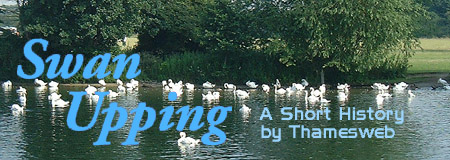
|


|

The following article was
originally printed in the first edition of Windlesora in 1981.
|
|
 |
This Royal mark was used throughout the reigns of George III, George IV, William IV and Queen Victoria. It is not clear when the marking of royal birds ceased but marks were reduced over 70 years ago at the instigation of Queen Alexandra who was concerned that the birds were hurt by the complex old marks.
 |
 |
 |
 |
 |
pre1500 |
College |
(ancient mark), now reduced to a single nick |
(ancient mark) now reduced to two nicks |
Above are examples of marks made on the Swans' bills taken from the "register of the Gylde Haule of Windesore" now in the Bodleian Library, Oxford, and "coppied from a Roll in the custody of the Maior and Bailiffs of New Wyndsor". This seems to date from the reign of Henry VIII (Ashmol. MS., No. 826, fol. 138-9b).
The "Windsor Roll" which formerly belonged to the Mayor and Bailiffs of New Windsor is the earliest known, and was probably compiled in the latter half of the 15th century, and is now only known from a seventeenth century copy by Ashmole.
140 "Swanmarks of Berkshire" are in the article of that name by N.F. Ticehurst, O.B.E., M.A., F.R.C.S. Eng., Journal of the Berks. Arch. Society, including the first two illustrated above.
All unmarked swans 'flying at liberty' belong to the crown, but on rare occasions the right was granted of taking such swans within a certain area, and for a limited time. In the reign of Edward III, on June 20th, 1356, such a grant was made under privy seal, for seven years, "to the Warden and College of the King's Free Chapel of Wyndesore of all swans flying, not marked, within the water of Thames between Oxford and London Bridge, as fully as these should pertain to the King by reason of his right and prerogative" (30 Ed.III., pt. II, m. 20)
There was a re-grant for a similar term in 1390, and this appears to have been extended for a further period, for on July 16th, 1398, the right of search was included in a grant to "Thomas Butiller, Dean of the King's Free Chapel of Wyndesore, and the College of that place ... that they may whenever and as often as they please search for swans throughout the said river, and all streams flowing to and from it, between Gravesend and Oxford Bridge" (22 Richard II, pt. I, m. 33).
There was a third renewal in 1400 to Richard Kyngeston, Dean of the King's Chapel and William Louency, Keeper of the great wardrobe, jointly, for a period of ten years (Henry IV, pt. VII, m 37). No record of the marks used under the above grants has been found. Before 1584, swans forefeit to the King were marked on the leg or foot.Foot Marking a Swan
(Reproduced from Bodleian MS, 204, f214, v. circa 1340)Some old photographs show the Dyers and Vintners wearing horizontally striped jerseys, (View photo from 1920s), one group with wider stripes than the other. All wore white trousers, and the swan masters had naval caps with a crown upon the badge.
A Report from 1981 On Monday 13th July 1981 a flotilla of six skiffs was towed upstream to Romney Lock by a motor launch. The swan upping had started at Sunbury and the men had taken their lunch at Staines. Two skiffs carried the Queen's Standard, two carried the flag of the Dyers' company and two the flag of the Vintners' company. The sovereign's crews wore red blazers or sweaters and were led by the Keeper of the Royal Swans, Capt. John Turk of Cookham, who took over the office from his father in 1963. The Dyers wore navy blue and Vintners white sweaters or dark green blazers.
While the level of the water was rising in Romney Lock the men stood (somewhat insecurely) in their boats and drank a toast to the Queen.(Editort's Note: a photograph from the late 40s shows this ceremony also taking place in the Lock Cut, upstream from Romney Lock. View photo.)
This is a tradition, as Romney is the nearest lock to the Queen's Thames home of Windsor Castle. From Romney Lock the party proceeded to the Donkey House public house, where years ago they would have stayed when it was called the Kings Arms, but now they go home at night and return in the morning to continue the journey upstream to Pangbourne.
The number of swans marked this year (1981) was the smallest ever, possibly because many birds are poisoned by retaining with the grit in their crops the lead weights used by anglers, or are strangled by their lines. Research is being carried out to resolve this problem, but it must be almost too late. In 1970 about 600 birds were counted, but in 1980 there were only 114.
H.M. Swan Keeper, Capt. F. J. Turk, M.V.O. states that in 1981 there were 14 broods and 54 cygnets. Of this total, there were 3 Dyer's Company swans and 16 cygnets. The Vintner's Company had 4 swans and 12 cygnets. The Queen's cygnets numbered 26.
Pamela Marson and Gordon Cullingham
The following note was added to this article in 1992 Fishermen now use weights that do not contain lead and as a result the number of swans is increasing. In 1991 there were 116 cygnets and in 1992 the total number of new cygnets marked was 136. There is as yet, no answer to the problem of those that are strangled by fishing lines.
See also More Swan Upping
InformationSwan Upping 2000 in Pictures News of The Regal Swan Project, Florida, USA Swan Sanctuary,
EghamRiver Thames
at WindsorRoyal Windsor
Home Page
To contact us, email Thamesweb.